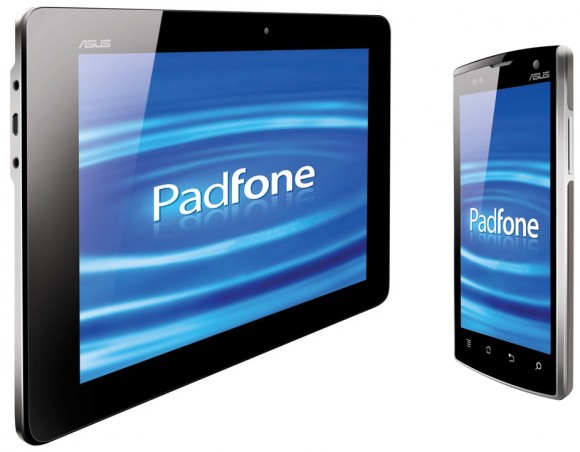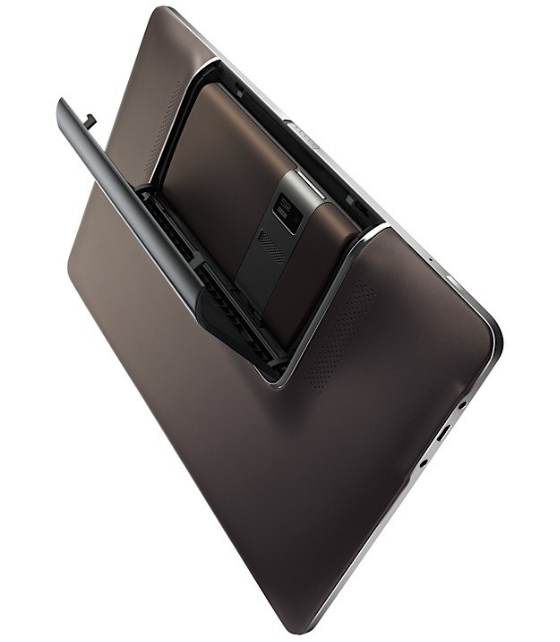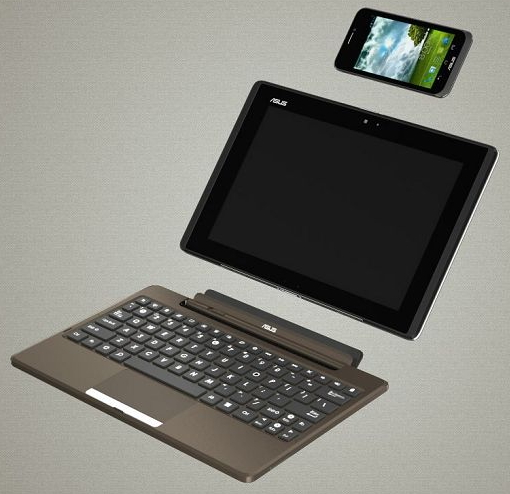ASUS, a Taiwanese multinational computer hardware and electronics company, has announced its latest innovative product that will provide its consumers a three in one device that will functions as a smartphone, can be transformed into a tablet, and to a netbook. The latest ASUS PadFone, together with its accessories — the PadFone Station, PadFone Station Dock, and PadFone Stylus Headset – was introduced to the public during the Mobile Word Congress (MWC) 2012 earlier this year. The Taiwanese company had accepted pre-orders for the ASUS PadFone last April 5, 2012 and the company has announced that their interesting product will be released to the Taiwan market on the 20th of April.
The ASUS PadFone is a smartphone that runs on the latest Android 4.0 Ice Cream Sandwich (ICS) OS and has loads of hardware and features that makes it one of the best mid-range smartphone to be released in the market. Attention was given is high regard to the new products of ASUS during the MWC 2012 and everyone intrigued and exciting with the endless potential that it can provide its users.
European consumers will not be waiting that long anymore since ASUS had already announced that it will be releasing the phone in Italy and presumably in other European countries in late May. Prices have also been announced which will reach to €699 for the phone, the tablet and the stylus/headset and the keyboard dock will cost the European consumers an additional of €149. Unfortunately for US consumers who are also eagerly waiting for this device, the company has not yet announced a release date in the US market. Also, ASUS has revealed its plan of releasing an LTE-enabled version of the ASUS PadFone this coming September 2012. For now, users can rely on the HSPA+ connectivity of the phone as well as its Wi-Fi capability.
Design, Screen, & Accessories:
ASUS PadFone came as a result of the company’s giant leap of taking its Transfer concept to the next level. The smartphone has dimensions of 128 mm x 65.4 mm x 9.2 mm (LxWxH) while the PadFone Station (tablet) has 273 mm x 176.9 mm x 13.55 mm (WxDxH), the devices weighs around 129 grams and 724 grams, respectively. At a landscape orientation, the left side of the Padfone Station consists of a 3.5 mm headphone jack and a volume rocker. The bottom is where you will find the charging port as well the docking port for the keyboard. On the left side of the phone, the micro USB port and the mini HDMI port can be noticed and volume rocker on the other side. The top part has the power button and 3.5mm audio jack. The Padfone dock also provides additional connectivity ports with additional two USB ports and a card reader
PadFone features a 4.3 inch qHD Super AMOLED touchscreen with capacitive multi-touch panel that has a resolution of 960 x 540p. The screen is also protected with Corning’s Gorilla Glass technology and with an HCLR film. On the other hand, the ASUS PadFone Station has a typical 10.1 inch WXGA TFT screen that also has capacitive multi-touch panel. It is also protected by the similar technology used in the PadFone. Thus, users can be assured that the smartphone and the tablet can live up to the threats of everyday use. Also, the use of Super AMOLED screen ensures that the users can experience high quality display even in sunny outdoor conditions.
The design of the cover the PadFone and the PadFone Station was based on the ASUS’ Zen design philosophy that we have first seen in the company’s ZENBOOK product. It is characterized by a series of concentric circles that can be observed in the back cover of both the phone and the tablet. This design results to a more comfortable grip and provides elegant aesthetics to the devices.
The main advantage of the phone is the potential savings that can be generated with the use of only one sim for all three devices, for making calls, sending text messages, and connecting the internet. Also, the device saves time in transferring work done in the smartphone to the tablet to the netbook and back. Actually this device does not do any synch operations or any sort of transfer because the ASUS PadFone smartphone functions as the core unit of the tablet. Meaning, everything that you are doing in your smartphone will be displayed on the tablet once it is inserted to the slot. There will be no need to restart the device. Same goes also vice versa, from tablet to smartphone.
Another great innovation made by ASUS is the addition of its stylus that also functions as a wireless headset. This allows the user to receive calls when the ASUS PadFone is tucked on the PadFone Station, it also adds up to the degree of personalization and creativity that can be done with tablet. The user can create doodles and jot down notes in images and also with its built-in app. Users that worry on being forgetful can stop worrying of losing their stylus since the devices includes an alarm system wherein the phone and the tablet beeps when both devices senses that the stylus is not is close proximity with them.
ASUS will also be giving a well designed sleeve that features a SIM card slot and an added cleaning cloth that is away from being seen, they have also utilized the brand tag as holder of the stylus.
Hardware, Connectivity & Features:
The ASUS PadFone is powered by a Qualcomm Snapdragon S4 8260A Dual-Core processor that is clocked at 1.5 GHz. For its graphics processing requirements, the phone is also equipped with an on-chip Qualcomm Adreno 225 GPU and 1 GB of RAM. The raw performance of this phone ensures that it can handle day-to-day tasks as well as meet the user’s demands for high quality games and entertainment.
This device is also equipped with several sensors such as G-sensor, Light sensor, motion sensor, vibration sensor (for PadFone Station), and proximity sensor. It also has sensors for its E-compass and Gyroscope.
For the internet connectivity, the device can use Wi-Fi to connect to hotspots or, on the occasion that there is no available hotspot, the device can connect to HSPA+ Networks with speeds that can reach up to 5.76 mbps for uploads and up to 21 mbps for downloads.
The PadFone also features microUSB and mini HDMI ports that can make file transfer and sharing movies, games and photos easier. The PadFone Station also includes a Phone Antenna and GPS Antenna to further improve the usability of the phone while it is tucked in the Station. One of its best feature is its High Quality speakers that is powered by the SonicMaster technology that delivers the most precise processing to produce superior quality audio. The resonance chambers of the speakers have also been increase to further enhance the user’s audio experience.
Camera & Storage:
The ASUS PadFone is not left out in terms of camera imaging quality. It houses an 8 megapixel camera that has autofocus feature and an LED Flash. The camera also has high aperture value of f/2.2 allowing the user’s to take greater control of shooting options. A 5-element has also been equipped in the camera of the phone that further improves the quality of photos even when it is zoomed out. Video recording in HD format is also possible with the phone’s camera. It can record HD videos at 1080p in MPEG format.
Storage is not that much of concern with the ASUS PadFone since it will be sold with variants 16GB, 32 GB and 64 GB. Even with the 16 GB variant, the storage space is sufficient for regular usage. However, ASUS did not stop there, the company also offers a 32 GB ASUS Webstorage for its users for a long span of three (3) years. The users also have the option to expand the storage capacity of the PadFone through its micro SD slot.
Battery:
The ingenious feature of these devices includes the increase of battery life when combining the PadFone peripherals. When the PadFone is transformed to a tablet, the battery life of the system increases to a total of 64 hours and it can be further improved by attaching the Station to the PadFone Dock which will greatly increase the battery life to 102 hours. This feature will provide the users an improved mobility which is very important for consumers that are always on the go.
The ASUS PadFone also manages its power well, while the phone is inserted in the PadFone Station, the Station charges the phones batteries. Same operation also happens when the Station is connected to the Dock. The Padfone has a 1520 mAh battery while the Padfone Station has an installed battery of 6600 mAh.
Conclusion:
The ASUS Padfone will totally change the way consumers will view a smartphone, a tablet, and a netbook. Consumers may consider how cost effective this product can be. There will be no need of purchasing three different gadgets that costs a lot, the ASUS Padfone will provide the user its basic requirements with a phone and a tablet. Prices have already been announced in Taiwan. The price for the phone is NT$17,990 or roughly $610 usd. The package including the Padfone, Station and Stylus woll cost around NT$28,901 or $850 and adding the Dock will have a total cost of NT$ 28.901 or $980 usd. However, prices in the US may be lower when the product will be made available in the country via mobile phone providers.
Performance and Usability makes this phone a worthy contented as one of the best mid-range smartphone. It’s capability to transform to a tablet and a netbook makes it even more exciting and appealing to consumers. For sure, this device will enter the market successful and will be embraced by consumers all over the world. For now, we just have to wait for the release date of the ASUS Padfone on our location. We will keep you updated regarding the release dates and prices. Stay tuned for more information.



